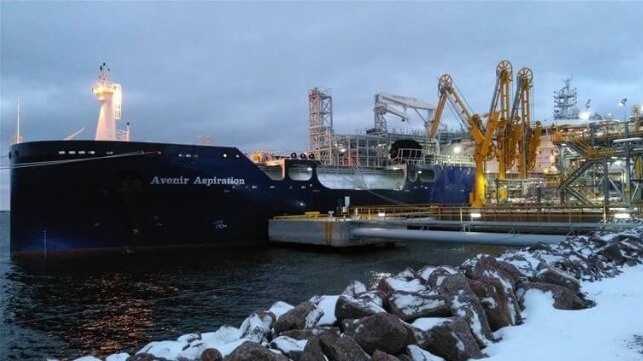Finland and Germany Starting LNG Imports

LNG import operations are beginning in both Finland and German as the countries race to complete their new gas facilities to replace the Russian supply of gas as colder winter temperatures reach the area. Both countries expedited efforts to launch FSRU operations with newly created import terminals.
UK-based Avenir is highlighting that it completed its first LNG delivery into the newly commissioned Hamina LNG terminal in Finland this week. The operation is jointly supplying Finland and Estonia via a pipeline connection. The terminal began operations at the beginning of October with a storage capacity of 30,000 cubic meters and regasification and injection services into the Finnish gas transmission network with a daily capacity of 4,800 MWh.
The LNG cargo was loaded by Avenir Supply & Trading onboard its vessel the Avenir Aspiration, a 4,500 dwt LNG tanker registered in Malta. The vessel which was delivered in October 2021 has a capacity of 7,500 cubic meters and is dual-purpose operating as a liquefied natural gas supply and bunkering vessel. The loading took place at the Murgardos terminal in Spain and the vessel completed offloading in Finland on November 22.
The company notes that a second vessel, the Avenir Ascension, another 4,500 dwt LNG carrier also with a capacity of 7,500 cbm, departed Spain on November 18 with the second shipment of LNG to the Hamina terminal. The vessel is currently in the Baltic and will make its delivery in a few days. Titan completed the first delivery to the terminal late in October offloading from the Optimus, a 6,200 cbm capacity LNG bunker vessel, supplying LNG from the terminal in Zeebrugge, Belgium purchased by Estonia’s energy company Alexela.
“Efficient movement of gas and LNG between EU member states is critical to bolstering energy security across the bloc as a whole,” noted Avenir. “Our deliveries into Finland further advances our strategy of becoming a leading supplier of LNG across Northern Europe.”
At the same time, today, November 23, the Norwegian-registered LNG tanker Neptune arrived in the German port of Mukran to complete preparation for the opening of Deutsche ReGas’s floating terminal. The 81,000 dwt vessel operated by Hoegh LNG has a capacity of 145, 130 cubic meters of liquid gas and will become the FSRU at Germany’s first privately financed LNG terminal.
The final preparation will be made before the vessel is transferred to the industrial port of Lubmin. This includes lightening the vessel to reduce her current draft of 9.6 meters to approximately 5.2 meters so that she can reach the facilities in Lubmin. In addition, they are installing a pipe adapter in order to ensure a precisely fitting connection to the existing shore-side pipe system.
With the Neptune having arrived in Germany, Dr. Stephan Knabe, Chairman of the Supervisory Board of Deutsche ReGas highlighted, “all the necessary components are now in the region to soon be able to technically complete the LNG terminal. The commissioning can of course only take place once all the necessary approvals have been obtained."
In Phase I, the FSRU will be located in the port of Lubmin and will be connected to the transmission network. The planned annual throughput capacity is at least 4.5 billion cubic meters with the LNG being moved from large tankers that will not be able to enter the port to shuttle tankers that will carry it to the FSRU. In Phase II, starting in December 2023, another floating LNG terminal with a planned annual throughput capacity of 7.0 billion cubic meters will be installed offshore. By relocating the first FSRU, the Neptune, from the port of Lubmin to an offshore location in 2024, the planned annual throughput capacity will be increased by a further 2.0 billion cubic meters. The planned annual throughput capacity of the Deutsche Ostsee LNG terminal will total at least 13.5 billion cubic meters starting in the fourth quarter of 2024.
Germany’s Federal Network Agency recently granted a 20-year exemption for Deutsche ReGas from tariff and network access regulation. The company is targeting commencing operations in Lubmin next week, December 1, pending final approval from the German authorities.
